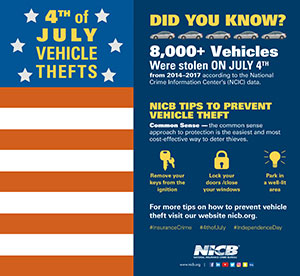Fourth of July Warning—Tips to Prevent Vehicle Theft
If you drive to a fireworks show, you could be walking home
DES PLAINES, Ill., July 1, 2019 — As the Fourth of July holiday nears, the National Insurance Crime Bureau (NICB) is reminding vehicle owners to secure their vehicles before heading off to enjoy any of the day’s celebrations.
Release Resources: Infographic
Independence Day falls in the middle of the pack for recording the most thefts according to NICB tracking data. According to the National Crime Information Center’s (NCIC) stolen vehicle file from 2014 through 2017, a total of 8,068 vehicle thefts occurred on the Fourth of July holiday.
“Vehicle theft impacts individuals in many ways and none of them are pleasant. It’s not just the loss of your transportation, it also involves possible financial loss, time away from work, securing alternative means of transportation and dealing with the criminal justice system should an arrest and prosecution materialize,” said Joe Wehrle, president and chief executive officer for NICB.
Take some time now and review NICB’s four “layers of protection” to guard against vehicle theft:
Common Sense — the common sense approach to protection is the easiest and most cost-effective way to thwart would-be thieves. You should always:
- Remove your keys from the ignition
- Lock your doors /close your windows
- Park in a well-lit area
Warning Device — the second layer of protection is a visible or audible device which alerts thieves that your vehicle is protected. Popular devices include:
- Audible alarms
- Steering column collars
- Steering wheel/brake pedal lock
- Brake locks
- Wheel locks
- Theft deterrent decals
- Identification markers in or on vehicle
- VIN etching
- Micro dot marking
Immobilizing Device — the third layer of protection is a device which prevents thieves from bypassing your ignition and hot-wiring the vehicle. Some electronic devices have computer chips in ignition keys. Other devices inhibit the flow of electricity or fuel to the engine until a hidden switch or button is activated. Some examples are:
- Smart keys
- Fuse cut-offs
- Kill switches
- Starter, ignition, and fuel pump disablers
- Wireless ignition authentication
Tracking Device — the final layer of protection is a tracking device which emits a signal to police or a monitoring station when the vehicle is stolen. Tracking devices are very effective in helping authorities recover stolen vehicles. Some systems employ “telematics” which combine GPS and wireless technologies to allow remote monitoring of a vehicle. If the vehicle is moved, the system will alert the owner and the vehicle can be tracked via computer.
